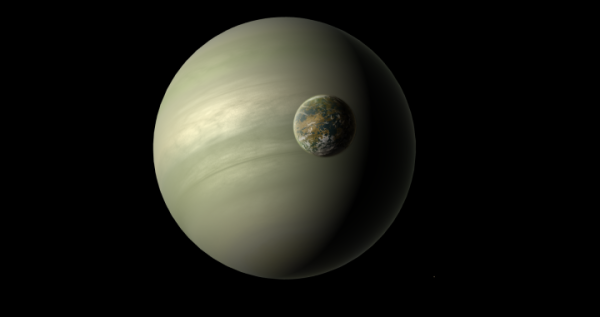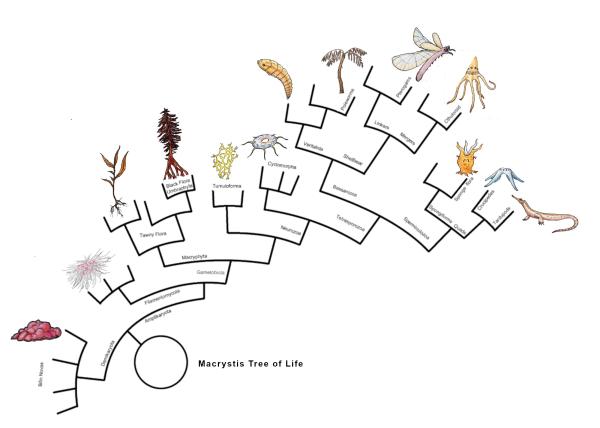BY LETTER
Macrystis (Garden World)
Galactography > Sephirotic Empires > Caretaker Gods
Galactography > Regions of Space > Middle Regions/Hinter-regions
Galactography > Sephirotic Empires > Solar Dominion
Galactography > Systems and Worlds > Systems & Worlds M - N
Science > Biology > Xenobiology
Galactography > Regions of Space > Middle Regions/Hinter-regions
Galactography > Sephirotic Empires > Solar Dominion
Galactography > Systems and Worlds > Systems & Worlds M - N
Science > Biology > Xenobiology
Garden World in Camelopardalis, Solar Dominion | |
 Image from Dangerous Safety and The Astronomer | |
| A distant view of Macrystis and Lontis, taken by the first exploratory probes | |
Macrystis - Data Panel | |
| Overview | Name: Macrystis Orbital characteristics: - Semi-major axis: 508.8 Mm - Orbital period: 3.51 days Physical characteristics: - Type: Videntian Macrobiotic HydroTerrestrial Lapi-Rhean Lacustrine Tundral AquaGaian Satellite - Mass: 0.813 earths - Radius: 0.935 Earths - surface acc: 0.93G - Albedo: 0.39 - Density: 5483 kg/m3 |
|---|---|
Macrystis is a Garden world, the largest moon of Lontis, a temperate gas giant. Macrystis has about 35% ocean coverage, much of it in an ocean on the side opposite from Lontis, along with a few shallower oceans on the Lontis-facing side. Most of the habitable land is tundra, as well as significant savanna, though the polar highlands can experience winters cold enough for carbon dioxide snow. Along continental margins, life thrives in temperate areas, while there are only tiny patches of tropical climates below sea level within tectonic rifts.
Macrystis's orbital period and day length are identical at 3.51 Terran days, as it is tidally locked to Lontis. Climate is subject to significant daily temperature swings, in some areas resulting in a daily freeze-thaw cycle, and much of the world experiences highly seasonal rainfall.
Macrystian life originated over 3.1 billion years ago, and macrobiotic life first evolved about 545 million years ago. Microbial and macroscopic colonial life with a common ancestry to Macrystian life exists on Lontis as well; although abiogenesis is a rare event on gas giants, life can sometimes be transferred from a life-bearing moon to a suitable jovian or neptunian world. While it is unknown whether Macrystian life reached Lontis via natural panspermia or was placed there by ancient xenosophonts, Lontis's trojan planetoids are unusually carbonaceous, suggesting that Lontis could have been naturally enriched in carbon via impacts billions of years ago, which would have provided a route for life to get a foothold on arrival.
a basic visual overview of the organisms on Macrystis |
 Image from Jay the Tardupod & TSSL |
Noteworthy clades on Macrystis include:
-Veritalids: worm-like fauna, usually armored, sometimes with many legs, including some megafaunal apex predators such as the swimming lion-dragon worm-Poleworms: A type of veritalid that have a symbiosis with photosynthetic algae (usually tawny) and now grow into the most widespread trees and grass-like flora.
-Pterogams: fuzzy flying chitinous organisms with hydrostatic limbs and mouthparts, a single sex, and the ability to link together neurally.
-Cthuloroids: Blind and soft-bodied deep sea organisms with stinging tentacles, whose life cycle involves multiple individuals merging together within a biomineralized cocoon.
-Quads: A diverse group, originally with four-way radial symmetry, walking on four limbs.
-Papercutters: A family of mite-sized quads often gengineered to be biobots, post colonization. More information.
-Tardupods: A type of quad that have developed bilateral symmetry, with endoskeletons and two or three legs (or fins), constituting most of the Macrystian megafauna.
-Sponge Flora: Relatives of quads with orange photosynthesis, which often resemble shrubs and cacti but have sponge-like flesh.
-Demikaryota: A domain of organisms characterized by the presence of a proto-nucleus (a simple membrane around the DNA). Demikaryotes diverged before full nucleus development. In the current period, most demikaryotes are pseudoalgae: microbial phytoplankton that produce oxygen during photosynthesis. Some minor methanogenic clades also exist, many of which are anaerobic.
-Bilin Novas: Bilin novas are a major clade of demikaryote flora, which create hard accretions and grow photosynthetic surfaces above them. While often found as pioneer species or in dry environments, they can exist in most biomes. Many are burgundy, but they come in various mixes of blue, red, and brown hues, such as wine, tan, and indigo.
-Amplikaryota: Amplikaryota is the domain equivalent to Earth's Eukaryota. They are named for amplifying parts of their genetic material via extra copies, and their reproductive method involves amitosis rather than meiosis. Their equivalents to mitochondria are mitohelices, which have a spiral shape. Most single-celled amplikaryotes are members of Paritria, which has developed paired chromosomes.
-Filamentomycota: Macrystian mold can be found decomposing dead matter both on land and in water. They typically grow as long filamentous structures called hyphae. Unlike Earth's fungi, their cell walls consist of cellulose rather than chitin. Most have a distinct mold form and a smaller reproductive form. Sprinkle molds are one major variety whose reproductive form appears as a tiny sprinkle, which disperses by sticking to fauna. Tuft molds are another major clade in which the reproductive form becomes a windborne ball of fluff. Filamentomycotans come in a profusion of vivid colors which vary by species and the material they decompose. More details here.
 Image from Jay the Tardupod | |
| Filamentomycota | |
-Gametobiota: Gametobionts are organisms that produce gametes and are capable of gene curation, which is the ability of cells to control the destination of their copied chromosomes while dividing. This ensures that both daughter cells retain essential genes after amitosis. Most of Macrystis's multicellular life falls into this group.
-Macryphyta: Macryphytes are gametobionts that developed photosynthesis via enveloped olive algae, giving them a tawny color. The first Macryphytes were free-living plasmodia, but over time, they evolved clusters and colonies that formed mounds, bubbles, and filaments, from which tawny and Umbraphytes arose.
-Tawny Flora: Tawny flora are truly multicellular Macryphytes. They are nonvascular and fill a variety of aquatic and small terrestrial niches, analogous to those of seaweeds, mosses, and other Terragen bryophytes.
One variety of Umbraphytes creates a unique regional biome known as the "mangrove taiga"
-Umbraphytes: Umbraphytes are tawny flora that adapted to low light conditions via dark cell pigmentation. This makes them suited to the deeper end of the sunlight zone, forest understories, and subpolar latitudes. It even allows some clades on the sub-Lontis hemisphere to use light reflected from Lontis to supplement their photosynthesis. One major Umbraphyte clade evolved vascular tissue, which has allowed several of them to grow into especially tall trees. These include the trees of the mangrove taiga, which grow downward from the canopy to form a thick complex of roots throughout the understory, creating a unique regional biome.
-Tumuloforma: A fungus-like grade of sessile heterotrophs, including decomposers, filter feeders, parasites, and carnivores. They are extremely diverse. Network tumuloforms form webs stretched across the bodies of organisms they are decomposing. Pitcher tumuloforms are shaped like a cup with fluid in the center, which can catch small organisms. They all require water for spawning so are largely absent from arid regions. The largest colonial organism on Macrystis is an underground tumuloform.
-Neurozoa: Neurozoa split from Tumuloforma with the development of a nervous system and are the main clade of fauna on Macrystis, making them analogous to Terragen Animalia. They are multicellular heterotrophs and have greater mobility than other clades. Their life cycle has two forms: a gametovite and a sporovite. Gametovites produce gametes, which conjugate and form zygotes. Zygotes grow into sporovites, which asexually produce spores that grow into gametovites.
-Cyclomorpha: Fauna that generally form ring-shaped colonies in their main gametovite stage. While they can exist on their own, most cyclomorphs congregate and link for protection, reproduction, and feeding, living as a colony for the majority of their lives. They can be found in nearly all aquatic environments worldwide. They are generally suspension filter-feeders, though they can be parasites, scavengers, deposit feeders, or detritivores.
Related Articles
Appears in Topics
Development Notes
Text by Steve Bowers as a short article on 07 December 2011
based on the original stub artcle by Anders Sandberg. Expanded 2020-present (2025) By Banelord, Salty, TSSL, Jay the Tardupod, Schwefel Kamm, Worldtree, DocViviLeandra, Dangerous Safety, Destructules, The Astronomer, Everything4404, Nomad, Cube67, Andonis, Oofles, MajGenrelativity, Teris, Dinomaster337, Cynognathus823, Nikolai- Prince of Denmark, Not Applicable, A Human For additional credits see below
Initially published on 01 January 2024.
updates to noteworthy clades added March 20, 2025
updates to noteworthy clades added April 8, 2025
You can download a printable 3d model of a Tardupod liquivore HERE, model by Andrew P
based on the original stub artcle by Anders Sandberg. Expanded 2020-present (2025) By Banelord, Salty, TSSL, Jay the Tardupod, Schwefel Kamm, Worldtree, DocViviLeandra, Dangerous Safety, Destructules, The Astronomer, Everything4404, Nomad, Cube67, Andonis, Oofles, MajGenrelativity, Teris, Dinomaster337, Cynognathus823, Nikolai- Prince of Denmark, Not Applicable, A Human For additional credits see below
Initially published on 01 January 2024.
updates to noteworthy clades added March 20, 2025
updates to noteworthy clades added April 8, 2025
You can download a printable 3d model of a Tardupod liquivore HERE, model by Andrew P






